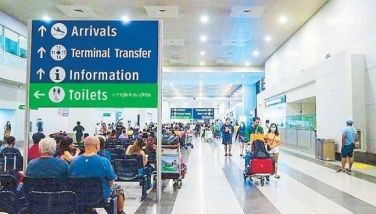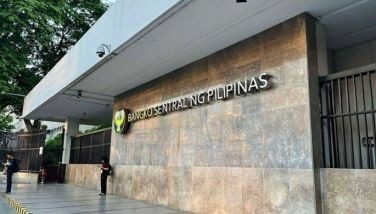DOF bucks restoration of NG direct lending scheme
September 20, 2006 | 12:00am
The restoration of the National Government’s publicly-funded direct lending program would ultimately kill existing micro-finance lending businesses, the Department of Finance (DOF) said yesterday.
The long-term effect of government direct lending in this specific sector of the credit market, according to Finance officials, would kill private initiative that have so far been successful at addressing micro-lending requirements.
Finance Undersecretary Gil Beltran told reporters that when public funds run out or when government mood shifts away from direct lending to small borrowers, there would be no private institutions to take up the slack.
Direct government lending to micro-borrowers was restored by the Arroyo administration under the controversial Executive Order (EO) 558 which repealed a previous executive order that limited government direct lending.
According to Beltran, EO 558 would have the immediate impact of taking market share away from micro-lending enterprises that already exist since they would not be able to compete with publicly-funded programs.
"When government subsidy dries out as they inevitably do, the whole micro-finance industry would no longer exist to fill in the void," Beltran said.
The DOF, however, admitted there was little it could do to prevent the implementation of the EO, unless it was recalled by President Arroyo herself.
Finance Secretary Margarito B. Teves earlier conceded that if recall was not possible, then Malacañang should at least limit the qualified agencies that would implement the program.
Before EO 558, the Arroyo administration had already issued a previous Executive Order 176 in 2003 which restored government subsidies on government loans and set aside P1.22 billion for a lending program that would be funded by government financial institutions.
EO 176 first restored direct lending to small borrowers, a policy that had cost previous administrations huge losses due to widespread default and corruption by the credit retailers.
Under EO 176, the Arroyo administration ordered the Land Bank of the Philippines, the Development Bank of the Philippines, the Technology and Livelihood Resource Center and the Small Business Guarantee and Finance Corp. to put up funds for the Arroyo program.
Dubbed as "Isang Bayan, Isang Produkto, Isang Milyong Piso" program, the facility was intended to provide a P1 million loan for every city or municipality in the country, supposedly to allow them to develop a product or service that can help assure its residents of a livelihood.
Landbank was directed to allocate P900 million out of its capital funds for its "Alleviate Poverty Trust Fund" which would be renamed "National Livelihood Support Fund".
Aside from this seed amount, Landbank was further ordered to put another P600 million fund while the DBP was asked to put in P500 million. The TLRC was asked to set aside P70 million and the SBGFC was to earmark P50 million for the program.
The long-term effect of government direct lending in this specific sector of the credit market, according to Finance officials, would kill private initiative that have so far been successful at addressing micro-lending requirements.
Finance Undersecretary Gil Beltran told reporters that when public funds run out or when government mood shifts away from direct lending to small borrowers, there would be no private institutions to take up the slack.
Direct government lending to micro-borrowers was restored by the Arroyo administration under the controversial Executive Order (EO) 558 which repealed a previous executive order that limited government direct lending.
According to Beltran, EO 558 would have the immediate impact of taking market share away from micro-lending enterprises that already exist since they would not be able to compete with publicly-funded programs.
"When government subsidy dries out as they inevitably do, the whole micro-finance industry would no longer exist to fill in the void," Beltran said.
The DOF, however, admitted there was little it could do to prevent the implementation of the EO, unless it was recalled by President Arroyo herself.
Finance Secretary Margarito B. Teves earlier conceded that if recall was not possible, then Malacañang should at least limit the qualified agencies that would implement the program.
Before EO 558, the Arroyo administration had already issued a previous Executive Order 176 in 2003 which restored government subsidies on government loans and set aside P1.22 billion for a lending program that would be funded by government financial institutions.
EO 176 first restored direct lending to small borrowers, a policy that had cost previous administrations huge losses due to widespread default and corruption by the credit retailers.
Under EO 176, the Arroyo administration ordered the Land Bank of the Philippines, the Development Bank of the Philippines, the Technology and Livelihood Resource Center and the Small Business Guarantee and Finance Corp. to put up funds for the Arroyo program.
Dubbed as "Isang Bayan, Isang Produkto, Isang Milyong Piso" program, the facility was intended to provide a P1 million loan for every city or municipality in the country, supposedly to allow them to develop a product or service that can help assure its residents of a livelihood.
Landbank was directed to allocate P900 million out of its capital funds for its "Alleviate Poverty Trust Fund" which would be renamed "National Livelihood Support Fund".
Aside from this seed amount, Landbank was further ordered to put another P600 million fund while the DBP was asked to put in P500 million. The TLRC was asked to set aside P70 million and the SBGFC was to earmark P50 million for the program.
BrandSpace Articles
<
>
- Latest
- Trending
Trending
Latest




























